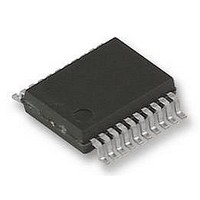LM20333MH National Semiconductor, LM20333MH Datasheet - Page 11

LM20333MH
Manufacturer Part Number
LM20333MH
Description
BUCK REG, 3A, ADJ, POWERWISE, 20TSSOP
Manufacturer
National Semiconductor
Datasheet
1.LM20333MH.pdf
(20 pages)
Specifications of LM20333MH
Primary Input Voltage
36V
No. Of Outputs
1
Output Voltage
32V
Output Current
3A
Voltage Regulator Case Style
TSSOP
No. Of Pins
20
Operating Temperature Range
-40°C To +125°C
Svhc
No SVHC
Lead Free Status / RoHS Status
Lead free / RoHS Compliant
Available stocks
Company
Part Number
Manufacturer
Quantity
Price
Part Number:
LM20333MH
Manufacturer:
NS/国半
Quantity:
20 000
Part Number:
LM20333MHX
Manufacturer:
NS/国半
Quantity:
20 000
glitches the PGOOD pin has 20 µs of built in deglitch time to
both rising and falling edges.
UVLO
The LM20333 has an internal under-voltage lockout protec-
tion circuit that keeps the device from switching until the input
voltage reaches 4.25V (typical). The UVLO threshold has 350
mV of hysteresis that keeps the device from responding to
power-on glitches during start up. If desired the turn-on point
of the supply can be changed by using the precision enable
pin and a resistor divider network connected to V
in Figure 5 in the design guide.
THERMAL PROTECTION
Internal thermal shutdown circuitry is provided to protect the
integrated circuit in the event that the maximum junction tem-
perature is exceeded. When activated, typically at 170°C, the
LM20333 tri-states the power FETs and resets soft-start. After
the junction cools to approximately 150°C, the part starts up
using the normal start up routine. This feature is provided to
prevent catastrophic failures from accidental device over-
heating.
Design Guide
This section walks the designer through the steps necessary
to select the external components to build a fully functional
power supply. As with any DC-DC converter numerous trade-
offs are possible to optimize the design for efficiency, size, or
performance. These will be taken into account and highlight-
ed throughout this discussion. To facilitate component selec-
tion discussions the circuit shown in Figure 1 below may be
used as a reference. Unless otherwise indicated all formulas
assume units of amps (A) for current, farads (F) for capaci-
tance, henries (H) for inductance and volts (V) for voltages.
The first equation to calculate for any buck converter is duty-
cycle. Ignoring conduction losses associated with the FETs
and parasitic resistances it can be approximated by:
INDUCTOR SELECTION (L)
The inductor value is determined based on the operating fre-
quency, load current, ripple current and duty cycle.
The inductor selected should have a saturation current rating
greater than the peak current limit of the device. Keep in mind
the specified current limit does not account for delay of the
current limit comparator, therefore the current limit in the ap-
FIGURE 1. Typical Application Circuit
IN
as shown
30051629
11
plication may be higher than the specified value. To optimize
the performance and prevent the device from entering current
limit at maximum load, the inductance is typically selected
such that the ripple current, Δi
rated output current. Figure 2 illustrates the switch and in-
ductor ripple current waveforms. Once the input voltage, out-
put voltage, operating frequency and desired ripple current
are known, the minimum value for the inductor can be calcu-
lated by the formula shown below:
If needed, slightly smaller value inductors can be used, how-
ever, the peak inductor current, I
below the peak current limit of the device. In general, the in-
ductor ripple current, Δi
rated output current to provide adequate current sense infor-
mation for the current mode control loop. If the ripple current
in the inductor is too low, the control loop will not have suffi-
cient current sense information and can be prone to instability.
OUTPUT CAPACITOR SELECTION (C
The output capacitor, C
and provides a source of charge for transient load conditions.
A wide range of output capacitors may be used with the
LM20333 that provide excellent performance. The best per-
formance is typically obtained using ceramic, SP or OSCON
type chemistries. Typical trade-offs are that the ceramic ca-
pacitor provides extremely low ESR to reduce the output
ripple voltage and noise spikes, while the SP and OSCON
capacitors provide a large bulk capacitance in a small volume
for transient loading conditions.
When selecting the value for the output capacitor, the two
performance characteristics to consider are the output volt-
age ripple and transient response. The output voltage ripple
can be approximated by using the following formula:
where, ΔV
at the power supply output, R
of the output capacitor, f
and C
The amount of output ripple that can be tolerated is applica-
tion specific; however a general recommendation is to keep
FIGURE 2. Switch and Inductor Current Waveforms
OUT
OUT
(F) is the output capacitance used in the design.
(V) is the amount of peak to peak voltage ripple
OUT
L
, should be more than 10% of the
SW
, filters the inductor ripple current
(Hz) is the switching frequency,
L
ESR
, is not greater than 30% of the
OUT
(Ω) is the series resistance
+ Δi
OUT
L
/2, should be kept
)
30051667
www.national.com











